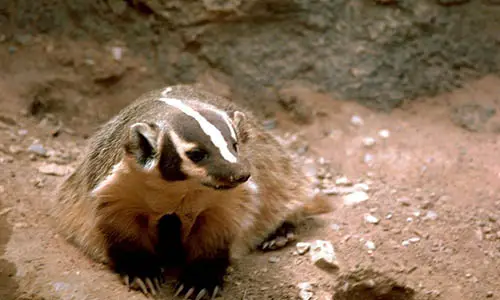Badgers are nocturnal mammals that belong to the weasel family, (Mustelidae). There are eight different species of badgers found in different parts of the world. They are powerful little animals. Their front paws are equipped with large heavy claws. This makes them excellent diggers. They have powerful jaws and anal scent glands. The different species of badgers have different habitats and their colouration ranges from grey to brown. All species of badgers have a stripe on their foreheads. Badgers are called fossorial animals. This means that they spend most of their time underground. This does not require much adaptation.
Badgers are small animals. A large male badger could be about 30 inches long and weigh 20 pounds. Their compact little bodies do not deter them from being formidable fighters. However they are not vicious. They are often mistakenly dubbed pests. Actually they play an important role in the ecosystem. They control rodent, insect and venomous snake populations. Their discarded burrows are used as nesting sites for the burrowing owl.
FACT 1: Of the eight different species of badgers only one species is endemic to the New World. The American badger is a greyish colour. It has a white stripe running from its nose to its neck. It lives in open dry country.
FACT 2: The American badger is a solitary animal. It spends the day in burrows that they have dug in the night. They come out at night to hunt. They are carnivores. They eat mice, ground squirrels, gophers and voles. They also eat insects, small reptiles and birds’ eggs.
FACT 3: The European badger is grey with a black and white stripe ion the nose. It is an omnivore. It eats earthworms, insects, birds, eggs and small mammals, as well as fruit and nuts. Badgers of the same genus are the Asian badger and the Japanese badger. They are called Old World Badgers.
FACT 4: Old World Badgers are social animals. They live in groups in setts. A sett is an extensive network of burrows dug by badgers.
FACT 5: Badgers mate late summer or autumn. However the zygote is implanted in early spring. After a six week gestation period, two or three young badgers are born in the late spring.
FACT 6: Badgers do not hibernate in winter. They are inactive on cold days and like to retreat to their warm, cozy, underground homes. Most of their prey either migrate or hibernate in winter. This makes for a lean badger winter They In order to survive this period of fasting; they accumulate large quantities of fat in late spring and autumn.
FACT 7: Ferret badgers or tree badgers are found in North East India, central China, Burma and other parts of South East Asia. They are similar to the other species of badgers, but are smaller.
FACT 8: Stink badgers have anal glands that produce an offensive strong smelling fluid. This can be sprayed for protection. These badgers have now been reclassified as skunks.
FACT 9: The ratel is often called a honey badger. It is a badger like animal. The honey badger is also a member of the weasel family. Its favourite food is honey, though it is an omnivore dining on the same foods as badgers. It is a fierce fighter and the female has been known to chase away jackals when protecting her cubs.
FACT 10: Wisconsin, USA, is called ‘the badger state. Badgers are the state animal of Wisconsin, USA. They are found all over the State, though rarely seen because of their solitary nature and nocturnal habits. In the 1800’s, miners in Wisconsin, used to dig tunnels into the hillsides, pursuing their search for lead. In winter they would sleep in these tunnels to keep warm. This badger like behaviour of the miners gave the state its nickname.











Leave a Reply